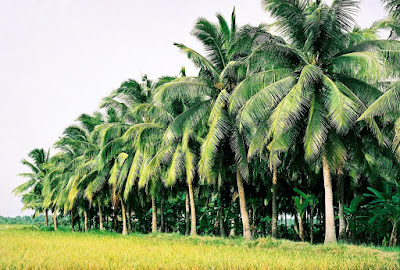Coconut palms (Cocos nucifera) grow best within U.S. Department of Agriculture plant hardiness zones 10 and 11 where they are cultivated as ornamental trees and for their edible fruit. Given the proper care and growing conditions, coconut palms produce their first fruit in six to ten years, but take 15 to 20 years to reach peak production.
Climate Requirements
Coconut palms occur naturally in the tropics, particularly in the southern Pacific Ocean. They are widely used as landscape trees within their native range, and in other locations with a comparably moist, humid climate. They are not frost tolerant and will develop potentially fatal fungal infections if exposed to cold. Coconut palms are sensitive and require temperatures above 72 degrees Fahrenheit and 30 to 50 inches of annual rainfall to successfully bear fruit. However, they will tolerate highly brackish water and salt spray with ease.
Growing Conditions
Coconut palms perform best when grown in full sun with moderately moist, fast-draining soil. Soil pH is not an issue, nor is soil salinity. Occasional flooding does not hurt coconut palm roots, but consistently submerged soil will eventually kill the tree. In areas where temperatures below 40 degrees Fahrenheit are common, plant coconut palms in a sheltered area against a south-facing wall to minimize cold damage. Better yet, grow the tree in a large container and move it indoors if cold temperatures are forecasted.
Care
Little care or attention is required to successfully cultivate coconuts, however, they do need occasional pruning to remove old fronds and during summer, regular watering. Many coconut palms experience significant nutrient deficiencies that may impact their ability to produce fruit. Regular feedings with palm formula fertilizer will help stave off any significant nutrient deficiencies without causing the tree any damage. Apply the fertilizer every three months at a rate of 1.5 pounds for every 100 square feet. The fertilizer should be spread evenly in the area directly beneath the tree's canopy.
Considerations
Most commercially available coconut palms were bred to resist common diseases; however, many are still susceptible to a pathogenic illness called lethal yellowing disease. The fronds of affected trees turn yellow, and the entire tree eventually dies. The only treatment is an antibiotic injection applied three times yearly by a certified arborist, which may prove costly over time. Additionally, coconut palms may prove dangerous if the fruit is left to ripen and fall. Plant them well away from trafficked areas to prevent injury from the falling fruit, or install catch-nets beneath the canopy to catch any falling fruit.
Author: Anstasia Leon

No comments:
Post a Comment